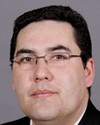They're side by side.
Evidence of meeting #4 for Indigenous and Northern Affairs in the 39th Parliament, 1st session. (The original version is on Parliament’s site, as are the minutes.) The winning word was data.
Evidence of meeting #4 for Indigenous and Northern Affairs in the 39th Parliament, 1st session. (The original version is on Parliament’s site, as are the minutes.) The winning word was data.
Conservative
A/Director, Strategic Research and Analysis Directorate, Department of Indian Affairs and Northern Development
Yes. When you refer to a Métis community, you probably refer to a fairly substantial density of Métis population. Here we didn't study population; we studied communities. There are Indian reserves, Indian settlements, villages Cris.... Those are geographies recognized as such, and we've looked at the well-being of those areas.
When you refer to these populations, they're not necessarily associated with an identified geographic area, as in the case of the Métis. So that's the challenge right now in terms of developing a CWB Métis. We have populations, we know where they are, but association with a specific geographic area.... Can this area be designated as a Métis community? Okay, then that's the score. But this step hasn't been fully taken yet.
Conservative

Inky Mark Conservative Dauphin—Swan River—Marquette, MB
Currently, I have quite a few Métis communities developing right alongside reserve communities.
A/Director, Strategic Research and Analysis Directorate, Department of Indian Affairs and Northern Development
As I said, the CWB has paid for all municipalities. Then the issue is coming up with a list of Métis communities.
Bloc

Yvon Lévesque Bloc Abitibi—Baie-James—Nunavik—Eeyou, QC
Some communities around Ungava Bay and Hudson's Bay are not indicated on the map. Is that because the people did not participate in the census or because these are Inuit communities?
A/Director, Strategic Research and Analysis Directorate, Department of Indian Affairs and Northern Development
That explains why I chose the slide.
In fact, we thought it would be a good idea to have two maps: one for first nations and the other for Inuit communities. You will find the same type of information on this map concerning the 51 Inuit communities for 2001.
A/Director, Strategic Research and Analysis Directorate, Department of Indian Affairs and Northern Development
I will conclude my presentation with the last slide.
Before I start explaining this chart, in any exercise, when you look at the past, you look at old reports like Hawthorn, and RCAP. When they tried to assess differences between first nations and other Canadians, Métis and other Canadians, or Inuit and other Canadians, they would base it on education. Then they would come up with an indicator, for example, proportion of university graduates. They would look at the labour force and the percentage of unemployment. They would look at income. They would use income per capita--usually they would use median income. Then they would look at housing and use a measure of crowding. They would compare the populations to the rest of the Canadian population. Then they would identify a gap in terms of well-being for that particular dimension of well-being.
But because we're using different measures across dimensions, we're unable to assess where the biggest gap is. Is it in education, health, housing, and so on? We're using different scales. We're using Fahrenheit and Celsius. Measure variations in Celsius; measure variations in Fahrenheit. If I don't have the equivalency table, I don't know. I can't compare.
The CWB, because it re-scales everything from zero to one for all dimensions of well-being that are included in the index, allows for these inter-dimensional comparisons. In other words, here I'm better able to see in which dimension of well-being the gap is the largest between first nations and other Canadians, and Inuit and other Canadians.
Two-thirds of the gap can be explained by housing and income. Personally, I think one should focus a little bit more on housing, because income is a measure of income per capita, and the gap is to some extent driven by differences in fertility. First nation and Inuit families have more kids, hence more dependants, which lowers their income per capita. But these differences in fertility are acceptable. There's no well-being issue there per se--just in the number of kids.
There is also the fact--you saw the age structure--that the aboriginal population is entering the labour market. Other Canadians are exiting the labour market. When you enter the labour market, your expectations in terms of wages are not at the same level as when you're leaving. In other words, you make a lot more money before you leave the labour market than when you just come in. So there are differences there in income that are related to differences in age structure, and we shouldn't necessarily read the income gap here as being discrimination in the labour market.
Housing is a lot clearer. There's crowding and repairs. The gap, as illustrated by the chart, is important. It's much larger than education. For registered Indians, it's three times the gap in education. But I'm not saying that the gap in education is not huge. The gap in housing is three times larger. This is relative. We're working with relative scales here. To have a true measure of the education gap, I suggest you go back to the education measures. How many kids come out of high school? How many kids come out of university? But in assessing where it's the largest, this is possibly the best attempt so far.
With that, I conclude my presentation, and I thank you.
Bloc

Yvon Lévesque Bloc Abitibi—Baie-James—Nunavik—Eeyou, QC
This one refers to workers. But does it refer to the number of workers available for work or to the number of people who are in the labour market?
A/Director, Strategic Research and Analysis Directorate, Department of Indian Affairs and Northern Development
It refers to the number of people in the labour market. It also indicates the proportion of people who are employed, as well as those who are unemployed.
NDP

Jean Crowder NDP Nanaimo—Cowichan, BC
I'd like to just come back to Bill C-31 for a minute. I'm curious. I had somebody bring me down the projections, and according to the projections the department has done, the number of people who do not qualify for registration is expected to increase from the current level of about 21,700 to nearly 400,000 within two generations.
I presume those kinds of demographic projections go to the policy-makers for some kind of review in future policy decisions. Is that the process?
A/Director, Strategic Research and Analysis Directorate, Department of Indian Affairs and Northern Development
All the information, yes. All the research we produce is out there and is shared with our policy colleagues.
NDP

Jean Crowder NDP Nanaimo—Cowichan, BC
You just produce the numbers and then somebody else makes policy as a result of them.
A/Director, Strategic Research and Analysis Directorate, Department of Indian Affairs and Northern Development
We produce the numbers, and then we give a lot of importance to communicating them in an understandable, palatable way to the policy folks. But after that, yes, it's up to them.
Liberal

Gary Merasty Liberal Desnethé—Missinippi—Churchill River, SK
I think the whole Bill C-31 issue is huge. I know it's at various stages within the court process, the various challenges to Bill C-31. I think it's very important to this committee to track when we talk about some of the related issues, and seriously address Bill C-31.
Conservative

Harold Albrecht Conservative Kitchener—Conestoga, ON
I have a question on this one here, where you show the comparison of population of aboriginal ancestry. Does the 37% for Canada include the aboriginals in its number?
A/Director, Strategic Research and Analysis Directorate, Department of Indian Affairs and Northern Development
Yes.
Conservative

Harold Albrecht Conservative Kitchener—Conestoga, ON
Okay. That's all of Canada, so it's not a contrast; it's inclusive of. That makes that population growth even larger than what it looks like at first glance here.
Okay, thanks.
A/Director, Strategic Research and Analysis Directorate, Department of Indian Affairs and Northern Development
The overall weight of the aboriginal population is around 3%, so it won't--
Conservative

Harold Albrecht Conservative Kitchener—Conestoga, ON
It's a small number, but the actual percentage would be skewed even higher if you excluded them from the first.
A/Director, Strategic Research and Analysis Directorate, Department of Indian Affairs and Northern Development
If we focused only on other Canadians, yes, the percent growth would be a little smaller.